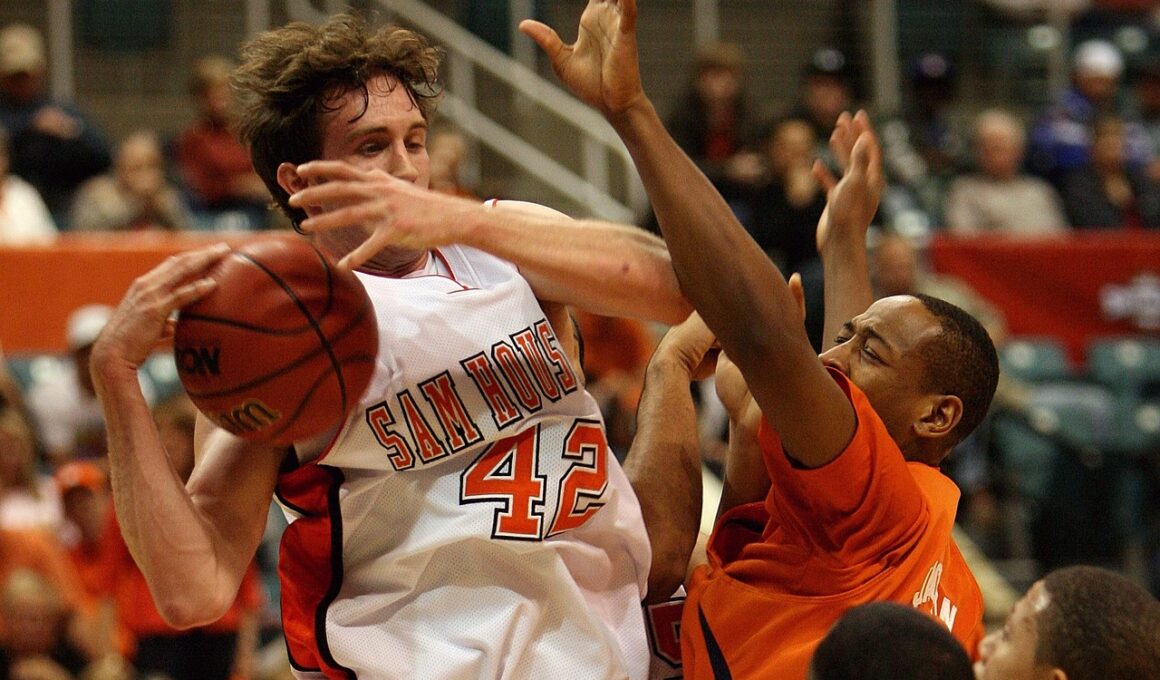Adapting Team Defense to Different Opponents
Understanding how to adapt team defense is crucial in the game of basketball. Teams must study their opponents to form a defensive strategy that addresses specific strengths and weaknesses. The focus should be on analyzing the opponent’s key players, their preferred play styles, and their tendencies on offense. A defensive scheme must be flexible and dynamic, able to change as the game progresses. In many cases, watching game footage of the opponent can provide valuable insights. Coaches can prepare players by highlighting potential plays the opponents favor. Regular practice also allows teams to experiment with how to adjust their formations for different adversaries. Overall, communication is vital, enabling players to react quickly on the court. Consider developing a system of signals during practice that can help the team stay organized. These signals can alert teammates to changes in defensive responsibilities or shifts in focus during gameplay. Ultimately, adaptability on defense could make a difference between winning and losing. Thus, teams prioritizing targeted defenses stand a better chance of achieving success in competitive environments. Regular discussions and workshops with the team can enhance this adaptive ability over time.
The choice between man-to-man and zone defense often depends on several factors. Each defensive strategy brings its unique benefits and challenges. For instance, a man-to-man defense allows for tighter pressure on specific opponents. Conversely, zone defense can cover more ground and help guard against sharp shooters or agile players. Teams should evaluate their own capabilities and their opponents’ characteristics to determine which strategy works better for them. If up against a team with strong individual players, a man-to-man approach may be necessary. In contrast, using a zone against a team that relies heavily on inside scoring might disrupt their rhythm. Also, switching defenses during games can confuse opponents; this unpredictability is often advantageous. Coaches should be prepared to make timely decisions to shift between strategies based on the flow of the game. Additionally, working on both defensive styles during practice fosters versatility among players. When players become proficient in both, they can effectively adapt their roles during a game. This breadth of skills among teammates can lead to better overall performance. Always embrace opportunities during practice to fine-tune and experiment with both styles, enhancing teamwork and individual growth in each player.
Defensive communication is a foundational aspect that underpins successful team strategies. A well-coordinated defense is built on players who understand their roles and maintain constant dialogue on the court. Establishing clear communication protocols is essential; players should call out screens, cuts, or changes in defensive schemes. This ensures that everyone is aware of their responsibilities. Moreover, creating a culture where players feel comfortable expressing their observations during gameplay can lead to better on-the-fly adjustments. Defensive leaders, often experienced or vocal players, should guide this communication. Encourage them to set the tone for interaction among teammates. Regular drills focusing on communication can help reinforce these habits in practice sessions. This allows players to develop instincts for speaking up at critical moments in games. Furthermore, consider incorporating exercises that emphasize team chemistry alongside communication. Trust among teammates significantly contributes to overall defensive effectiveness. When players are synchronized and actively engaging with each other vocally, it reduces confusion and promotes smarter plays. Thus, establishing effective channels of communication can greatly improve team dynamics, leading to solid defensive performances against various styles of opposing offenses, ultimately impacting game outcomes positively.
Adapting to Offensive Styles
Each opponent’s offensive style can dictate defensive adaptations, whether it’s a fast-paced game or a slow, deliberate attack. Understanding how to navigate various offensive systems can impact defensive success significantly. For example, if facing a high-tempo team, defenses must prioritize transitional defense to minimize fast-break opportunities. Failing to adapt could result in numerous easy points for the opposing team. On the other hand, against a team that utilizes a slower pace and emphasizes half-court plays, a more patient, disciplined defense can be effective. Players must learn to read and anticipate the opposing players’ movements. Workshops and targeted training sessions can drill these reading skills, preparing defenders to respond effectively. Offering simulations of various offensive styles during practice can also help prepare the team. This approach teaches players how to adjust their mindsets and strategies accordingly. To foster this adaptability, encourage your team to work through specific game scenarios together. Ultimately, having both prepared strategies and the ability to adapt on-the-spot will create a formidable defensive unit that can handle any challenge presented in a competitive setting.
Conditioning plays an often-underestimated role in a team’s ability to adapt defensively. Players who are in peak physical condition can sustain high defensive intensity, crucial for effectively responding to diverse styles of play. An effective conditioning program should incorporate agility drills, endurance building, and strength training. These elements will contribute to a player’s ability to change direction quickly and maintain defensive stances longer. Additionally, tailored conditioning training should simulate game situations to enhance performance under actual competitive conditions. Implementing varied drills can help increase stamina and strength while also fostering teamwork. Furthermore, monitoring players’ limits is essential. Ensuring they don’t overexert themselves during training creates a balance that maintains optimal performance levels during games. Therefore, consider creating a targeted approach for different players based on their positions. The strategies should align with the demands they will face on the court. When players are adequately prepared physically, they are more likely to execute strategies efficiently. Thus it is essential to intertwine conditioning with team strategies for a comprehensive preparation plan. Strong physical capabilities facilitate quicker adjustments on defense and enhance team resilience against varying opponent tactics.
Evaluating Defensive Performance
Regular assessment of defensive performance helps teams refine their strategies. Using game footage serves as a valuable tool for analysis, enabling players and coaches to spot weaknesses. Analyzing plays that succeeded or failed provides insights into where improvements are needed; look for tendencies or missed opportunities. This evaluation not only assists in adapting strategies but also in reinforcing fundamentals. Evaluate players’ individual performances as well, recognizing those who excel and those who may need additional support. Formative feedback sessions can empower players to learn from both successes and mistakes. Utilize team meetings to encourage discussion around defensive breakdowns. Relay findings about recurring issues and identify collaborative solutions. In addition, develop a system for tracking progress over time. Tracking metrics, like opponent scoring averages, can provide a clearer picture of defensive effectiveness. With consistent evaluation, players can adapt and better prepare for future games. Ultimately, a commitment to ongoing evaluation enhances every player’s development. Learning from past performances fosters a culture grounded in growth, adaptability, and resilience, ensuring defensive strategies are continuously evolving to meet the challenges posed by different opponents over time.
The integration of analytics and modern technology into defensive strategies can help tailor approaches for different opponents. Utilizing data visualization tools assists teams in breaking down their opponents’ tendencies to ascertain where adjustments are needed. Statistical analysis provides insights into which players excel at certain types of shots, allowing for strategic defensive placements. Furthermore, technologies such as wearable devices monitor players’ physical exertion levels and efficiency throughout matches. This data can inform coaches when to optimize rotations for defensive matchups. Implementing video analysis tools can also enhance this understanding. Coaches should review not only their strategies but also those implemented by successful teams. There is much to learn from others in the league regarding how they adapt defensively. Attending workshops focusing on technology applications in basketball can keep teams ahead of the curve. Continue to prioritize learning opportunities as new techniques and strategies evolve. Ultimately, this blend of analytics and technology creates an informed, modernized approach to defensive adaptations. It allows the team to stay competitive against diverse opponents while ensuring players are well-prepared for the unexpected and challenging scenarios faced on the court.
In conclusion, adapting team defense for different opponents is a critical aspect of basketball. Success hinges on a combination of understanding the opponent’s strengths, effective communication, and continuous evaluation of performance. Conditioning and mastering flexible defensive strategies play pivotal roles in achieving desired outcomes on the court. Similarly, embracing technology fosters informed tactics while ensuring players are physically primed for their roles. Ultimately, it’s important to foster a cohesive team unit capable of adjusting to both individual player strengths and team strategies from opponents. The dedication to ongoing learning, practice, and adaptation will lead to improved team performance. Regularly revising strategies based on evolving trends within the league keeps teams competitive and resilient. Encourage players to share feedback and insights to create a collaborative environment that fosters trust and development. As teams continue to refine their approaches, they will find themselves better equipped to face a myriad of challenges ahead. Hence, the journey of adapting team defense cannot be overlooked. Instead, it should be embraced as a significant opportunity for growth and improvement in achieving a successful basketball season.


